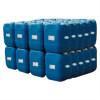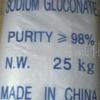| Model: | - |
|---|---|
| Brand: | Qingdao Aoyate Chemicals Co.,Ltd |
| Origin: | Made In China |
| Category: | Chemicals / Organic Chemical Materials / Other Organic Chemical Materials |
| Label: | - |
| Price: |
-
|
| Min. Order: | - |
Product Description
Lactic acid (IUPAC systematic name: 2-hydroxypropanoic acid), also known as Milk Acid, is a chemical compound that plays a role in several biochemical processes. It was first isolated in 1780 by a Swedish chemist, Carl Wilhelm Scheele, and is a carboxylic acid with a chemical formula of C3H6O3. It has a hydroxyl group adjacent to the carboxyl group, making it an alpha hydroxy acid (AHA). In solution, it can lose a proton from the acidic group, producing the lactate ion CH3CH(OH)COO. It is miscible with water or ethanol, and is hygroscopic.
Lactic acid is chiral and has two optical isomers. One is known as L-(+)-lactic acid or (S)-lactic acid and the other, its mirror image, is D-(-)-lactic acid or (R)-lactic acid. L-(+)-Lactic acid is the biologically important isomer.
In animals, L-lactate is constantly produced from pyruvate via the enzyme lactate dehydrogenase (LDH) in a process of fermentation during normal metabolism and exercise. It does not increase in concentration until the rate of lactate production exceeds the rate of lactate removal which is governed by a number of factors including: Monocarboxylate transporters, concentration and isoform of LDH and oxidative capacity of tissues. The concentration of blood lactate is usually 1-2 mmol/L at rest, but can rise to over 20 mmol/L during intense exertion.
Industrially, lactic acid fermentation is performed by Lactobacillus bacteria, among others. These bacteria can operate in the mouth; The acid they produce is responsible for the tooth decay known as caries.
In medicine, lactate is one of the main components of Ringer's lactate or lactated Ringer's solution (Compound Sodium Lactate or Hartmann's Solution in the UK). This intravenous fluid consists of sodium and potassium cations, with lactate and chloride anions, in solution with distilled water in concentration so as to be isotonic compared to human blood. It is most commonly used for fluid resuscitation after blood loss due to trauma, surgery, or a burn injury.
Lactic acid is primarily found in sour milk products, such as: Koumiss, leban, yogurt, kefir and some cottage cheeses. The casein in fermented milk is coagulated (curdled) by lactic acid.
Although it can be fermented from lactose (milk sugar), most commercially used lactic acid is derived by using bacteria such as Bacillus acidilacti, Lactobacillus delbueckii or Lactobacillus cus to ferment carbohydrates from nondairy sources such as cornstarch, potatoes and molasses. Thus, although it is commonly known as "milk acid", vegan products can contain lactic acid as an ingredient.
Lactic acid may also be found in various processed foods, usually either as a pH adjusting ingredient, or as a preservative (either as antioxidant or for control of pathogenic micro-organisms). It may also be used as a fermentation booster in rye and sourdough breads. [3]
Lactic acid is also present in wheat beers, especially lambic, due to the activity of Pediococcus damnosus. [4]
Lactic acid is widely used for inhibiting pathogenic bacteria like E. Coli, Salmonella, Campylobacter and Listeria on animal carcasses like beef, pork and poultry during the slaughtering process.
Potassium lactate, sodium lactate and calcium lactate are the neutralized salts of lactic acid. Potassium lactate is used in many fresh and cooked meat products for shelf life control, color preservation and reduction of sodium content. Sodium lactate has a mild saline taste and is therefore suitable for flavour enhancement in meat products as well. Sodium lactate is being produced as liquids as well as powders. Calcium lactate is popular for fortification and improved texture in emulsified meat products like frankfurters.
Lactic acid is chiral and has two optical isomers. One is known as L-(+)-lactic acid or (S)-lactic acid and the other, its mirror image, is D-(-)-lactic acid or (R)-lactic acid. L-(+)-Lactic acid is the biologically important isomer.
In animals, L-lactate is constantly produced from pyruvate via the enzyme lactate dehydrogenase (LDH) in a process of fermentation during normal metabolism and exercise. It does not increase in concentration until the rate of lactate production exceeds the rate of lactate removal which is governed by a number of factors including: Monocarboxylate transporters, concentration and isoform of LDH and oxidative capacity of tissues. The concentration of blood lactate is usually 1-2 mmol/L at rest, but can rise to over 20 mmol/L during intense exertion.
Industrially, lactic acid fermentation is performed by Lactobacillus bacteria, among others. These bacteria can operate in the mouth; The acid they produce is responsible for the tooth decay known as caries.
In medicine, lactate is one of the main components of Ringer's lactate or lactated Ringer's solution (Compound Sodium Lactate or Hartmann's Solution in the UK). This intravenous fluid consists of sodium and potassium cations, with lactate and chloride anions, in solution with distilled water in concentration so as to be isotonic compared to human blood. It is most commonly used for fluid resuscitation after blood loss due to trauma, surgery, or a burn injury.
Lactic acid is primarily found in sour milk products, such as: Koumiss, leban, yogurt, kefir and some cottage cheeses. The casein in fermented milk is coagulated (curdled) by lactic acid.
Although it can be fermented from lactose (milk sugar), most commercially used lactic acid is derived by using bacteria such as Bacillus acidilacti, Lactobacillus delbueckii or Lactobacillus cus to ferment carbohydrates from nondairy sources such as cornstarch, potatoes and molasses. Thus, although it is commonly known as "milk acid", vegan products can contain lactic acid as an ingredient.
Lactic acid may also be found in various processed foods, usually either as a pH adjusting ingredient, or as a preservative (either as antioxidant or for control of pathogenic micro-organisms). It may also be used as a fermentation booster in rye and sourdough breads. [3]
Lactic acid is also present in wheat beers, especially lambic, due to the activity of Pediococcus damnosus. [4]
Lactic acid is widely used for inhibiting pathogenic bacteria like E. Coli, Salmonella, Campylobacter and Listeria on animal carcasses like beef, pork and poultry during the slaughtering process.
Potassium lactate, sodium lactate and calcium lactate are the neutralized salts of lactic acid. Potassium lactate is used in many fresh and cooked meat products for shelf life control, color preservation and reduction of sodium content. Sodium lactate has a mild saline taste and is therefore suitable for flavour enhancement in meat products as well. Sodium lactate is being produced as liquids as well as powders. Calcium lactate is popular for fortification and improved texture in emulsified meat products like frankfurters.
Member Information
| Qingdao Aoyate Chemicals Co.,Ltd | |
|---|---|
| Country/Region: | Shan Dong - China |
| Business Nature: | Manufacturer |
| Phone: | 13863984738 |
| Contact: | Helen Lee (Sales Assistant) |
| Last Online: | 09 Nov, 2009 |





